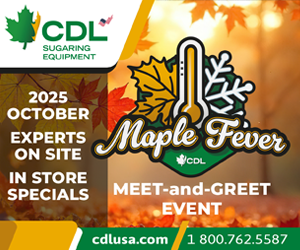Food Safety & Gov't Regulations
Tips on passing sugarhouse inspections and complying with regs
Midwest inspector shares what to look for in a compliant sugarhouse
By PAUL POST | MAY 19, 2021
MADISON, Wisc.—Complying with ever-changing government rules and regulations can be a burdensome challenge for any small business operator.
Sugarmakers are no exception.
But it's important for the industry to maintain a high standard of quality and consumer confidence. A Wisconsin state official told how the licensing and inspection process helps achieve such goals and what inspectors are trained to look for in his presentation, "Requirements of Facilities Used Solely for Concentration of Maple Sap."
Stefan Boerboom, a manufactured food specialist with the Wisconsin Department of Agriculture, Trade and Consumer Protection, gave his highly informative talk during the recent Wisconsin Maple Producers Association Winter Institute.
While directed toward people in his state, the principles, advice and good management practices he shared benefit producers everywhere as he covered a wide range of topics from building maintenance to personal hygiene.
In addition to ensuring food safety, by adhering to the rules he outlined, sugarmakers can pass inspections easily and avoid costly, time-consuming and highly stressful mistakes.
KEEP BUILDINGS CLEAN
"The area around the building must be well drained," Boerboom said. "During an inspection we're going to be evaluating the facility for standing water and any other potential health nuisance. We do expect there to be mud when the sap is flowing, but it shouldn't be entering the process area. Grading around your building should keep standing water away."
At one site, Boerboom had to cross 10 feet of ice and mud to enter the building. "Inside there was a cracked slab and two inches of water on top," he said. "That was not a good deal. That would not meet our expectations."
He cited several other examples of potential health problems such as leaking gas cans, wood piles stacked up against buildings where critters can nest, and spare unused buckets that hold standing water where algae can form.
"You're allowed to keep one day's supply of firewood or other fuel inside, but the remainder must be kept outside so it doesn't attract pests in your building," he said.
Building floors must be smooth, cleanable and durable.
"So gravel floors aren't allowed," Boerboom said. "If you wash it through to the ground underneath, that doesn't count. If you've got pitting and cracks in your floor those need to be patched and sealed up.
Also, there is a minimum lighting requirement of 10-foot candles (108 lux).
"You certainly wouldn't want any less for cleaning," he said. "The idea is to make cleaning easier."
Light-colored walls and ceilings are preferable. White fiberglass plastic, found quite often in the food industry, is good for cleaning and durability.
"If you have a bare studded wall or ceiling and decide to paint it, first be sure that the paint is formulated to withstand high levels of temperature and moisture," Boerboom said. "The last thing you want to do is climb up on a ladder and scrape off loose peeling paint from the ceiling after a few years. If you're able to keep walls and ceilings visibly clean without wet washing, then you're technically not going to have to make them impervious to moisture, but you are in your bottling room where a MERV 7 or better air filter is required."
NO PESTS
Keeping walls and ceilings sealed against the outdoors is another key requirement.
"No leaky roof, of course, but you also have to make sure you aren't getting any birds or insects in there," Boerboom said. "Our expectation is that you keep pests out at all times."
If using pesticides, these should be stored safely away from food and labeled instructions must be followed closely. "Don't store them above or next to any food," he said. "Store them in a way that they can't possibly contaminate food or harm somebody. And anything with bait or powder (that animals might track) is not allowed. Keep garbage separated in a tight container and keep containers clean so they don't attract pests."
He suggested mesh screening and putting weather stripping on doors to keep pests out. Also, doors outside the concentration room must be kept closed when not in use.
"However, keeping doors closed should not create a ventilation issue, either," Boerboom said. "You have to have enough ventilation that condensation does not form on surfaces other than in your evaporator where it's supposed to. So go ahead and crack a window, but keep it screened."
Pets and livestock aren't allowed in buildings, either.
FOOD CONTACT SURFACES
Equipment and utensils must be cleaned as often as necessary to remove visible debris. Lead, copper and alloys are prohibited as a food contact surface, and the re-use of filter papers is not allowed.
In addition, diatomaceous earth must be non-toxic and defoamers may not contain any major food allergens such as soy or peanut oil.
SANITATION
All employees must have convenient access to toilets and a hand washing sink. Portable toilets might be an option if used in compliance with Department of Natural Resources regulations.
The same hand washing sink may be used for the toilet room and processing area, but "you've got to have water under pressure, a soap dispenser, and if no paper towels then some other single-service means of drying hands -- no cloth towels -- and a trash bin," Boerboom said.
Hot and cold water is required to wash and sanitize utensils, so the hand washing sink should have both, too.
All sewage and liquid waste must be disposed of in a sanitary manner. A low-impact discharge general permit and other permits may be required from the Department of Natural Resources.
Condensate from thermal concentration may only be reused to clean non-food contact surfaces such as the outside of an evaporator, not the inside.
"But you don't' have to test for turbidity or have an automated fail-safe diverter," Boerboom said.
PERSONNEL STANDARDS
Federal regulations require employees to complete written training in the principles of food hygiene and safety, including the importance of employee health and personal hygiene. "This is something you need to have a written record of," Boerboom said.
As a rule, all employees should:
* Maintain a high degree of personal cleanliness and observe good hygienic practices.
* Wash hands before beginning work and upon returning to work. "If you cut wood and have debris on your jacket, change your jacket or shake it off and make sure no contaminants are making their way into your product," he said. "Even if you filter it, there's no excuse for being negligent. If you can reasonably prevent something, you need to do so."
* Do not work when you are ill or have open exposed wounds.
* Do not eat, drink or use tobacco in food processing areas or anywhere else that you're storing food.
RECORD KEEPING
"One of the best ways to keep an inspection moving smoothly and quickly is to have a folder set aside for inspections with records if we ask for it . and procedures for maintaining hygiene at your facility," he said. "If you have a food safety plan, that's great. Keep it together with records you might expect us to ask for.
































